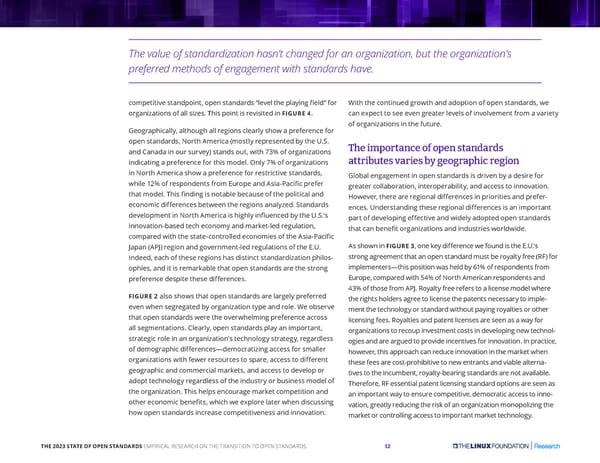The value of standardization hasn’t changed for an organization, but the organization’s preferred methods of engagement with standards have. competitive standpoint, open standards “level the playing field” for With the continued growth and adoption of open standards, we FIGURE 4. organizations of all sizes. This point is revisited in can expect to see even greater levels of involvement from a variety of organizations in the future. Geographically, although all regions clearly show a preference for open standards, North America (mostly represented by the U.S. The importance of open standards and Canada in our survey) stands out, with 73% of organizations indicating a preference for this model. Only 7% of organizations attributes varies by geographic region in North America show a preference for restrictive standards, Global engagement in open standards is driven by a desire for while 12% of respondents from Europe and Asia-Pacific prefer greater collaboration, interoperability, and access to innovation. that model. This finding is notable because of the political and However, there are regional differences in priorities and prefer- economic differences between the regions analyzed. Standards ences. Understanding these regional differences is an important development in North America is highly influenced by the U.S.’s part of developing effective and widely adopted open standards innovation-based tech economy and market-led regulation, that can benefit organizations and industries worldwide. compared with the state-controlled economies of the Asia-Pacific FIGURE 3, one key difference we found is the E.U.’s Japan (APJ) region and government-led regulations of the E.U. As shown in Indeed, each of these regions has distinct standardization philos- strong agreement that an open standard must be royalty free (RF) for ophies, and it is remarkable that open standards are the strong implementers—this position was held by 61% of respondents from preference despite these differences. Europe, compared with 54% of North American respondents and 43% of those from APJ. Royalty free refers to a license model where FIGURE 2 also shows that open standards are largely preferred the rights holders agree to license the patents necessary to imple- even when segregated by organization type and role. We observe ment the technology or standard without paying royalties or other that open standards were the overwhelming preference across licensing fees. Royalties and patent licenses are seen as a way for all segmentations. Clearly, open standards play an important, organizations to recoup investment costs in developing new technol- strategic role in an organization’s technology strategy, regardless ogies and are argued to provide incentives for innovation. In practice, of demographic differences—democratizing access for smaller however, this approach can reduce innovation in the market when organizations with fewer resources to spare, access to different these fees are cost-prohibitive to new entrants and viable alterna- geographic and commercial markets, and access to develop or tives to the incumbent, royalty-bearing standards are not available. adopt technology regardless of the industry or business model of Therefore, RF essential patent licensing standard options are seen as the organization. This helps encourage market competition and an important way to ensure competitive, democratic access to inno- other economic benefits, which we explore later when discussing vation, greatly reducing the risk of an organization monopolizing the how open standards increase competitiveness and innovation. market or controlling access to important market technology. THE 2023 STATE OF OPEN STANDARDS EMPIRICAL RESEARCH ON THE TRANSITION TO OPEN STANDARDS 12
 The 2023 State of Open Standards Page 11 Page 13
The 2023 State of Open Standards Page 11 Page 13